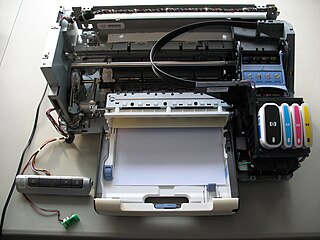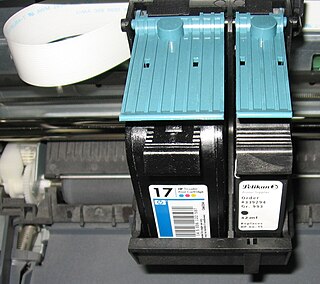
In computing, a printer is a peripheral device which makes a persistent representation of graphics or text, usually on paper. While most output is human-readable, bar code printers are an example of an expanded use for printers. The different types of printers include 3D printer, inkjet printer, laser printer, thermal printer, etc.

Inkjet printing is a type of computer printing that recreates a digital image by propelling droplets of ink onto paper and plastic substrates. Inkjet printers are the most commonly used type of printer, and range from small inexpensive consumer models to expensive professional machines.

Dye-sublimation printing is a computer printing technique which uses heat to transfer dye onto materials such as a plastic, card, paper, or fabric. The sublimation name was first applied because the dye was considered to make the transition between the solid and gas states without going through a liquid stage. This understanding of the process was later shown to be incorrect, as there is some liquefying of the dye. Since then, the proper name for the process has become known as dye-diffusion, though this technically-correct term has not supplanted the original name. Many consumer and professional dye-sublimation printers are designed and used for producing photographic prints, ID cards, clothing, and more.

An MFP, multi-functional, all-in-one (AIO), or multi-function device (MFD), is an office machine which incorporates the functionality of multiple devices in one, so as to have a smaller footprint in a home or small business setting, or to provide centralized document management/distribution/production in a large-office setting. A typical MFP may act as a combination of some or all of the following devices: email, fax, photocopier, printer, scanner.

Ecma is a standards organization for information and communication systems. It acquired its current name in 1994, when the European Computer Manufacturers Association (ECMA) changed its name to reflect the organization's global reach and activities. As a consequence, the name is no longer considered an acronym and no longer uses full capitalization.
The StyleWriter brand is a line of inkjet serial printers by Apple, targeted mainly towards consumers. They produced print quality that was better than the dot matrix ImageWriters, and were cheaper than the LaserWriters. All but a few models contained Canon print engines, while the last few were re-badged HP DeskJet printers. When Steve Jobs returned to Apple in 1997, he discontinued most of the company's accessory product lines, including the StyleWriter and LaserWriter.

Seiko Epson Corporation, or simply Epson, is a Japanese electronics company and one of the world's largest manufacturers of computer printers, and information and imaging related equipment. Headquartered in Suwa, Nagano, Japan, the company has numerous subsidiaries worldwide and manufactures inkjet, dot matrix and laser printers, scanners, desktop computers, business, multimedia and home theatre projectors, large home theatre televisions, robots and industrial automation equipment, point of sale docket printers and cash registers, laptops, integrated circuits, LCD components and other associated electronic components. It is one of three core companies of the Seiko Group, a name traditionally known for manufacturing Seiko timepieces since its founding.
Print permanence refers to the longevity of printed material, especially photographs, and preservation issues. Over time, the optical density, color balance, lustre, and other qualities of a print will degrade. The rate at which deterioration occurs depends primarily on two main factors: the print itself, that is, the colorants used to form the image and the medium on which image resides, and the type of environment the print is exposed to.

A continuous ink system (CIS), also known as a continuous ink supply system (CISS), a continuous flow system (CFS), an automatic ink refill system (AIRS), a bulk feed ink system (BFIS), or an off-axis ink delivery system (OIDS) is a method for delivering a large volume of liquid ink to a comparatively small inkjet printhead. Many business and professional grade printers incorporate a continuous ink system in their design to increase printing capacity.

An ink cartridge or inkjet cartridge is a component of an inkjet printer that contains the ink that is deposited onto paper during printing.

Solid ink is one technology used in computer printers and multifunction devices. Although originally credited with creation by Tektronix in 1986 it was also credited to Howtek, Inc in 1985. Howtek Solid inks could print millions of colors by subtractive color deposition (layering). The Pixelmaster, a Howtek product, printed with 32 single nozzle inkjets mounted in a rotating reservoir with 8 nozzles per color. It was designed to print on standard sheet paper in 4 minutes with alpha-numeric or images. The Pixelmaster was manufactured by Juki Corporation and sold by Howtek, Inc., Hudson, NH.
ISO/IEC 19752Information technology — Method for the determination of toner cartridge yield for monochromatic electrophotographic printers and multi-function devices that contain printer components is an ISO standard method for the determination of toner cartridge yield for monochrome laser printers, introduced in June 2004.
Compatible ink is manufactured by third party manufacturers and is designed to work in designated printers without infringing on patents of printer manufacturers. Compatible inks and toners may come in a variety of packaging including sealed plastic wraps or taped plastic wraps. Regardless of packaging, compatible products are generally priced lower than original equipment manufacturer (OEM) brand inks and toners.
Dynamic Cassette International (DCI) is an internationally recognised Boston, Lincolnshire, UK based ink cartridge and laser toner manufacturing company, producing products under the Jet Tec brand name. DCI is the sole UK manufacturer of compatible ink cartridges. DCI is notable for winning the Queen's Award for Enterprise: Innovation in 2004 and the Queen's Award for Export and being one of the biggest employers in Boston, employing over 300 staff at its 40,000 square metres factory. The company is currently Europe's largest manufacturer of compatible inkjet cartridges and has a turnover in excess of £20 million.

A toner cartridge, also called laser toner, is the consumable component of a laser printer. Toner cartridges contain toner powder, a fine, dry mixture of plastic particles, carbon, and black or other coloring agents that make the actual image on the paper. The toner is transferred to paper via an electrostatically charged drum unit, and fused onto the paper by heated rollers during the printing process. It will not stain like ink cartridges, but it can get messy if handled improperly.









